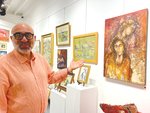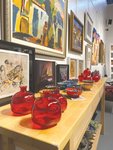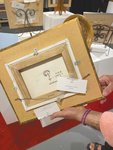By ARDEN BASTIA After 20 years on Federal Hill, Gallery Z moves to 100 Bellows St. in Warwick with a collection of more than 100 works, all by Armenian artists. The new space, which can be described as delightfully eclectic, is currently showcasing 111
This item is available in full to subscribers.
We have recently launched a new and improved website. To continue reading, you will need to either log into your subscriber account, or purchase a new subscription.
If you are a current print subscriber, you can set up a free website account by clicking here.
Otherwise, click here to view your options for subscribing.
Please log in to continue |
|



After 20 years on Federal Hill, Gallery Z moves to 100 Bellows St. in Warwick with a collection of more than 100 works, all by Armenian artists.
The new space, which can be described as delightfully eclectic, is currently showcasing 111 works from 49 Armenian artists from around the world, 27 of whom are no longer living.
From the outside, the gallery resembles a storage unit, and it’s easy to miss the entrance entirely but for the Gallery Z ArtMobile parked out front. The large, red vehicle, dubbed Moby, used to be a FedEx truck before gallery director Berge Ara Zobian transformed it into a mobile gallery. The ArtMobile is built to bring visual arts, as well as performance art, film projection and installations, to communities that may not have access to a gallery or museum. Moby has made trips to public and private schools, libraries, college campuses, nursing homes, festivals and vacant parking lots.
Under bright lights, two floors of art, valued at more than $300,000, are ready to be appreciated by gallery visitors.
The history of Gallery Z begins with Zobian’s own story.
Zobian, who is of Armenian descent, was born in Syria and grew up in Lebanon. He moved to Queens in the early 1970s with his family. Zobian studied photography and sociology at Queen’s College.
In the mid ’80s, Zobian moved to Providence, where he taught at Rhode Island College and became immersed in the state’s Armenian culture. For 40 years, Zobian worked as a photographer with a brief stint as a stringer with the Associated Press, which took him on assignments to places like Mexico, Israel, Cyprus, Bulgaria and Syria. Zobian’s first language is Armenian, but he picked up French and Arabic from his time with the AP. Zobian’s work has appeared nationally and internationally in newspapers and magazines as he’s worked for social, political and religious organizations.
In the late 1990s, Zobian dabbled with the idea of opening a gallery. His first gallery space opened in 2001 in Olneyville, in the same space as his photography studio. The gallery was called a “hole in the wall,” according to Zobian, which only attracted more of an audience. In 2003, he moved Gallery Z to historic Federal Hill, taking up residence next to the former Scialo Brothers Bakery.
Zobian called this move a “gamble,” since Federal Hill was known for its food, not its art. But Zobian found great success there.
During his time on Federal Hill, Zobian supplied nearly a dozen restaurants, cafes, offices and businesses throughout the state with art through a lending program.
Prior to the COVID-19 pandemic, Zobian hosted elaborate candlelit dinner parties at Gallery Z, with 50 or so invited guests. Zobian is looking forward to resuming these events.
In an interview on Friday, Zobian emphasized the importance of his first exhibit in the new space.
“This exhibit is very dear because of my Armenian ancestry,” Zobian said. “Sharing art, fine art, and only originals, we don’t have any reproductions, and only Armenian art is dear to me because it represents my history, the culture, and it tells stories.”
He explained that about 70 percent of the art on display is from his own personal collection. Visitors to the gallery have the chance to see sculpture, collages, landscapes and portraits in everything from pastels to oil paint to watercolors.
Zobian shared the story of one artist, Simon Samsonian, who has several works on display at Gallery Z. “He was born in 1915, and he was cut out of his mother’s womb, honest to God, during the Armenian Genocide massacres and became an instant orphan. They sent him to Corfu, and then the orphanage closed so they sent him to Alexandria in Egypt, and then he moved to Manhattan where he became a big, successful artist.”
Zobian met Samsonian in 1975 when he photographed the artist and was lucky enough, over the years, to buy several of his paintings for his collection. Samsonian tragically became senile and destroyed much of his own artwork by painting over it, and passed away in 2003.
Zobian described Samsonian’s work as having “a focus on the strength of the individual lines and the harmony found when they are balanced.” Much of his work incorporates the colors of the Armenian flag, red, yellow and blue.
Touring the gallery, stopping every few feet to gaze at another work, Zobian shared stories of other artists, like Lara Baghdassarian, who paints under the name Lara B.
Originally from Beirut, Lara is known for her technique of painting in candlelight. She started painting with oils but made the switch to mixed media. Gallery Z showcases both her portraits, many of them her own nudes, as well as her collage work.
“It’s not all about money. If it sells, it’s almost sad because I’m parting with it,” Zobian said as he gestured to portraits dating back to the early 20th century. “A lot of these pieces are very historic, archival pieces.”
Zobian pointed out one painting, a watercolor on paper, from Eduard Isaabekian in 1982. The subject is his Russian mistress, and this is the only piece of his work left in Zobian’s possession.
The work is unique, according to Zobian, since Isaabekian traditionally worked with oils. “This is a $6,000 piece,” he said. “And so if this piece sells, hey, I can pay my bills, I’m happy. But if you sell the piece, you have no more Isaabekian pieces left, so it’s very dear.”
But for Zobian, the most important part about buying, selling and showing art is sharing. For Zobian, understanding the history of each piece and the artist’s influences is the key takeaway from galleries like his.
“Art education is very important,” Zobian said as he perched on the second floor, gazing down at the gallery in a bird’s eye view. “It’s not about me as much as I can know about the artist and their biographies and their styles, the idea is that the artist has their own influence and their own likes and dislikes. It’s important to know where that magenta came from, or if that is a 16th-century Flemish Dutch style of something. Where is it coming from? What was their moment? What was their inspiration?”
The Armenian art exhibit will be available to view for the next several months. Zobian has plans for another exhibit later in the year, but no announcements have been made yet. Next year, he wants to show quarterly exhibits instead of the traditional month-long exhibits.
Gallery Z is open at 100 Bellows St., on Thursdays from noon to 7 p.m. and Saturdays from noon to 5 p.m. Appointments are strongly recommended with a 24-hour notice, and can be made by calling (401) 454-8844 or emailing Berge at bergezobian@aol.com. For more information about the artists and artwork on display, visit armenianartgalleryz.com.
Comments
No comments on this item Please log in to comment by clicking here